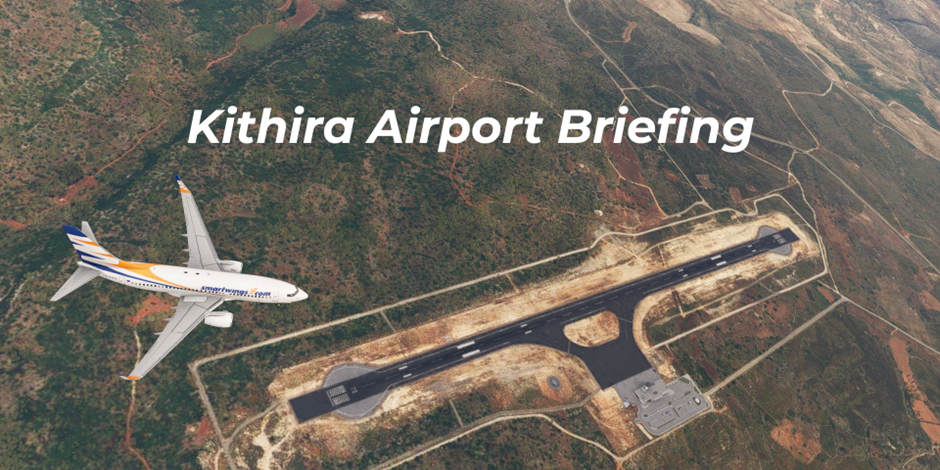¶ Kithira Airport
The information in this document is not intended for real aviation. It is only intended for computer-based flight simulation.

Kithira Airport (LGKC/KIT) is located on the island of the same name in Greece, between the Peloponnese peninsula and the western tip of Crete. The runway is only 1461 metres long – it is one of the shortest runways where Smartwings ever operated their Boeing 737 aircraft (although only the B737-700 variant actually flew here). In real life, there are also other constraints and limitations: fuel unavailability, low fire category, and low load capacity of the operating surfaces.
This document summarizes essential information you should know for a realistic flight simulator experience.
For more information, please refer to the real-life Aeronautical Information Publication (AIP):
https://aisgr.hasp.gov.gr/
¶ Scenery
Recommended LGKC scenery for MSFS:
Kolibri Simulations - payware
Greek Airfields part 2 - freeware
Recommended LGKC scenery for X-Plane:
HawkSimulations - freeware
Recommended LGKC scenery for P3D:
Kolibri Simulations - payware
AVSIM Library - freeware
¶ Přílet
When planning your flight to Kithira Airport, please note that there is no fuel available. Therefore, you need to bring fuel for the next leg with you on arrival (this is called tankering). This is a significant factor affecting the weight of the aircraft and therefore its landing performance (the length of runway required for slowing down safely).
LCTR and VOR non-precision approach procedures are available for both landing directions. Similar to other airports in Greece, switching to a visual approach is common when visual contact is made with the runway, if weather permits.
Considering the length of the runway (1461 m), we strongly recommend planning the landing with the highest possible flap setting (B737: 40° flaps), and using maximum manual braking after touchdown.
Turnarounds on the runway can only be done where the runway is widened, i.e. using the turn pad at the end of the runway. The width of the runway is 30 metres.
Parking on the apron is done parallel to the terminal (i.e. "sideways" in relation to the terminal building), and always against the wind direction: typically, if landing on runway 02, the aircraft is parked north-northeast, and vice versa. Pushback is not used here, the aircraft departs the stand on its own.
¶ Odlet
In real life, there is no fuel available at the airport. Therefore, it is necessary to bring fuel for the next leg with you on arrival.
The weight of the aircraft significantly affects takeoff performance (the runway length required for take-off). Due to the very limited runway length at LGKC (and the unavailability of fuel), flights from here are operated with a tech stop – thus, there is only fuel on board for the flight to the stopover airport. It is also usually necessary to reduce the payload; a fully loaded aircraft will simply not be able to depart from here.
During the stopover – in past seasons, the airport on Limnos, or Kalamata in the southern Peloponnese – the aircraft is refuelled, and often additional passengers board for the flight. A direct flight from Kithira to more distant destinations (e.g. Prague) without a stopover can only be made if the aircraft is empty and the unused weight is used for fuel, so usually only on the first flight at the start of the season.
We strongly recommend planning your take-off with higher flap settings (B737: 15° or 25°) due to the length of the runway. It is necessary to use the full length of the runway, i.e. backtrack the runway before departure and use the turn pad at the end of the runway.